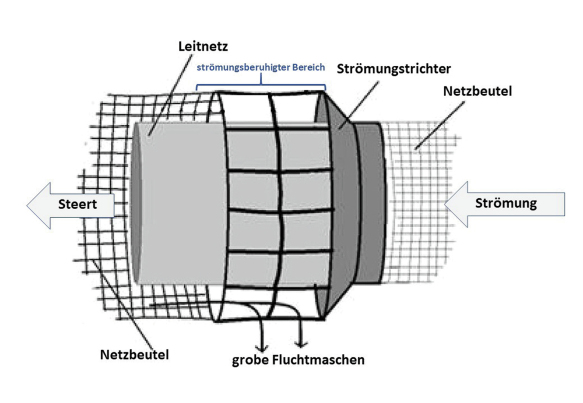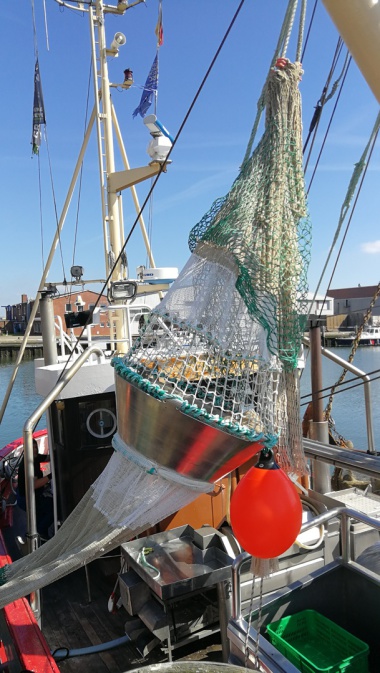MiniFish
Unintentionally, a significant number of fish end up as bycatch in shrimp fishery. The "MiniFish" project aims to investigate how the proportion of fish can be minimized. A special flow funnel is being tested, which is designed to allow fish to escape from the net. The research project began in August of this year, with the first test catches scheduled for September. Financed by the EU and the state of Schleswig-Holstein, the project will run until July 2025.
Bycatch has been a highly debated issue for decades between fishermen and environmentalists, especially since fishing takes place partially within protected areas. Despite research results failing to demonstrate detrimental effects of the brown shrimp fishery on the ecosystem, and despite the fact that the fishery has held the Marine Stewardship Council (MSC) sustainability certification since 2017, the issue of bycatch is more relevant than ever. In addition to criticism and demands from the conservation side, the brown shrimp fishery also has an obligation to work towards a solution to the problem. Progress in bycatch reduction must be achieved for the MSC re-certification process in 2024.
Unwanted bycatch is a globally existing problem in almost every fishery. Solutions to avoid unwanted bycatch have been sought worldwide for decades. While a general ban on discarding catch in fishing was introduced in the EU's Common Fisheries Policy in 2019, other national and international bodies primarily focus on solutions through fishing techniques and equipment. Brown shrimp fishing also employs such a method: a specially mandated "sieve" or "fish net" regulated by national and EU ordinances, works well for larger fish, approximately 15 cm in length, but is less effective for smaller fish species. Bycatch often includes juvenile fish of commercially exploited species like herring, sprat, or plaice. The majority, however, are species significant for the Wadden Sea food web and biodiversity of this habitat. This includes endangered species like river lamprey, twaite shad, and poor cod.
Assistance in reducing bycatch is expected from a special flow funnel in the fishing net. It leverages behavioural and physiological differences between fish and shrimp to minimize fish bycatch. The flow funnel was developed by American fisheries scientists at the University of Mississippi. In 2015, they introduced a device that significantly reduced fish bycatch for shrimp trawlers in the Gulf of Mexico, without negatively impacting the shrimp catch (Parsons & Foster 2015: Reducing bycatch in the United States Gulf of Mexico shrimp trawl fishery with an emphasis on red snapper bycatch reduction. Fish Res. 167: 201-215). The target species of shrimp fishermen in the Gulf of Mexico are the much larger 'brown' and 'white shrimps' Penaeus aztecus and Litopenaeus setiferus, and also the bycatch fish such as: B. the 'red snapper' (Lutjanus campechanus) differ in size from the North Sea species, but what is crucial is the basic idea of the flow funnel, which is to be adapted and tested to the conditions of the brown shrimp fishery in the North Sea as part of “MiniFish”.
The flow funnel changes the current speed within the net on a small scale, to which crabs and fish react differently. Shrimps have limited sensory abilities to perceive water flow, and they are not strong swimmers, mostly orienting themselves with the prevailing current. In contrast, fish detect even slight changes in water flow through their lateral line organ and adjust their behaviour accordingly. They typically swim against the current. Video recordings in the net have shown that fish recognize the flow-calmed areas and actively seek them out. In this part of the net, directly behind the flow funnel, mesh sizes are chosen to be large enough for fish to escape through.
In the initial phase of the project, the flow funnel will be tested for its basic suitability. Alongside demonstrating the reduction of fish in the bycatch, a crucial criterion is that catch efficiency for brown shrimp is not negatively or only marginally affected. Another aspect during testing is the practicality of use on board and the behaviour of the gear during towing. For these tests, the Büsum shrimp fisherman Jan Möller is providing his cutter SC 14 "Maret". Together with deckhand Karl Lippert and the senior member of the fishing family, Rainer Möller, the project has a knowledgeable and motivated team of practitioners at its disposal. Additional cutters will be needed for the continuation of “MiniFisch” in the next year. Fishermen and fisherwomen interested or with questions and suggestions about the project are encouraged to get in contact.



